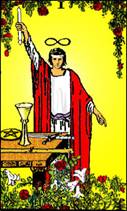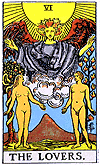Tarot and the Sign of Gemini
By Anthony Louis
On May 21, the Sun began its month-long journey through Gemini, the sign of the zodiac associated with the lovers trump of the tarot. The sign Gemini belongs to the element air and is ruled by the mental planet Mercury (the Greek messenger of the gods), which is linked to the Magician trump of the tarot. The tarot's air suit of swords illustrates typical scenes of daily life related to intellect, communication, logic, strife, conflict, choice, decision-making and the overcoming of adversity.
Gemini and Brotherly Love
Gemini (Latin for "twins") is the third sign of the zodiac, but the first to use human figures as its emblem (Aries is the ram, and Taurus the bull). The original Gemini twins were Castor and Pollux (Polydeuces), born to Queen Leda who slept with the god Zeus and then with King Tyndareus of Sparta in quick succession. Castor is the immortal son of Zeus (Jupiter), and Pollux is his mortal "twin" brother. The boys so loved each other that they were inseparable. When Pollux died in battle, immortal Castor begged Zeus to allow him to join Pollux forever in the afterlife. As a result, the two boys were placed in the heavens in the constellation of Gemini, the Twins. This embodiment of archetypal brotherly love may explain why those with Gemini prominent in their natal charts are often drawn to homoerotic relationships.
Twinship in the Star Castor of the Constellation Gemini
Under an ordinary telescope, the star Castor of Gemini resolves into three stars: two that revolve around a common center of gravity plus a fainter third star which is a red dwarf. Under greater magnification, these three stars can each be resolved into double stars, for a total of six. The theme of twinship is thus repeated three times in the "single" star Castor, the immortal twin.
Gemini, Difficult Choices and the Trojan War
The mythology of Gemini is replete with difficult decisions. Castor had to choose between living as an immortal god or joining his brother forever in the afterlife. Other choices centered on Helen of Troy and Clytemnestra, the "twin" sisters of Castor and Pollux. Like Pollux, Clytemnestra was mortal, but Helen, being fathered by Zeus, was immortal.
The trouble with Troy began when Zeus forgot to invite Eris, the goddess of strife, to a popular wedding. To avenge the slight, Eris sent a golden apple to the wedding with the inscription "To the most beautiful goddess of all." Athena, Hera and Aphrodite immediately claimed the prize, and a bitchy controversy ensued. To settle the dispute, the three goddesses agreed to binding arbitration by Paris of Troy - the sexiest man alive. Aphrodite bribed Paris with the promise of the Greek beauty Helen (then of Sparta). Paris decided in favor of Aphrodite who, in turn, helped Paris to steal Helen from her husband, the Greek hero Menelaus. Helen, who already had the hots for Paris, did not put up much resistance. The Greeks went to war against Troy to reclaim Helen, who throughout the war was divided in her loyalty to the Trojans and to her native Greek compatriots.
The Lovers and the Magician Cards of the Tarot
 The Rider-Waite-Smith Magician card, numbered one, depicts a young man in magician's robes. In his right hand he holds a wand directed heavenward. His left hand points earthward - perhaps a reference to the ancient teaching, "As above, so below." Above his head is a lemniscate (sideways figure eight) symbolizing infinity, eternity and the spiritual forces that the magician seeks to manipulate. Before him stands a table with four objects (a disk, a chalice, a sword and a rod) representing the four elements and the four suits of the tarot. Around his waist he wears a belt in the form of an ouroborus, a serpent devouring its own tail. Because of its circular shape and tail-devouring aspect, the ouroborus is a symbol of the cyclical nature of life and death - a major theme that runs throughout the major arcana of the tarot. The Rider-Waite-Smith Magician card, numbered one, depicts a young man in magician's robes. In his right hand he holds a wand directed heavenward. His left hand points earthward - perhaps a reference to the ancient teaching, "As above, so below." Above his head is a lemniscate (sideways figure eight) symbolizing infinity, eternity and the spiritual forces that the magician seeks to manipulate. Before him stands a table with four objects (a disk, a chalice, a sword and a rod) representing the four elements and the four suits of the tarot. Around his waist he wears a belt in the form of an ouroborus, a serpent devouring its own tail. Because of its circular shape and tail-devouring aspect, the ouroborus is a symbol of the cyclical nature of life and death - a major theme that runs throughout the major arcana of the tarot.
 The Rider-Waite-Smith Lovers trump, numbered six (like the six stars in Castor), is a representation of the biblical story of Adam and Eve in the garden before the fall. Behind the two lovers stands an angel. Eve stands next to the tree of knowledge of good and evil, and around that tree is coiled the snake that circles the waist of the magician in card one of the tarot. Adam stands next to the tree of life with its twelve fruits, one for each sign of the zodiac. The Rider-Waite-Smith Lovers trump, numbered six (like the six stars in Castor), is a representation of the biblical story of Adam and Eve in the garden before the fall. Behind the two lovers stands an angel. Eve stands next to the tree of knowledge of good and evil, and around that tree is coiled the snake that circles the waist of the magician in card one of the tarot. Adam stands next to the tree of life with its twelve fruits, one for each sign of the zodiac.
In the Hebrew bible, God created Adam in God's image and likeness. Because Adam was lonely, God took a rib from Adam to create Eve, also in his image and likeness - a type of twinship. Adam and Eve were the lovers who started the human race. The serpent convinced God's human creations to eat the forbidden fruit (perhaps an apple as in the myth of Helen of Troy). Human suffering and misery was the outcome of that primal choice.
Tarot Meditations While the Sun Is in Gemini
The period when the Sun transits through Gemini is an excellent time to meditate on the tarot's lovers and magician cards, as well as the suit of swords of the minor arcana. Ponder the myths of Castor and Pollux, and of Helen of Troy. Do you show your loved one how much you really care? What are the important decisions you are facing in your life and what are the potential consequences? Where must you turn away from the things of childhood and assume your position as an adult member of society? How can you use your talents to work magic in your own life and in the lives of those around you?
To prepare for meditation, sit or lie in a comfortable place and allow your body to be free of tension and distractions. Pay attention to your breathing. Feel your breath go in and out as you inhale and exhale. If distracting thoughts enter your mind, simply observe them and allow them to float by as you gently return your attention to your breathing. When you have established a steady, comfortable tempo of breathing rhythmically in and out, turn your focus to the tarot card you have selected for meditation.
Observe the card and contemplate its images. Imagine yourself as a character or element in the card. In your mind's eye, enter the card and become part of its scene. What are you thinking and feeling? What questions are you asking of the other characters in the card? What do they expect of you? What is the story that underlines the scene on the card? How does that story relate to your own life? Take your time playing out the story as if you were in a dream. When you have completed you meditation, you may wish to record your observations in a tarot notebook for review later on.
Recommended Reading
Tarot Plain & Simple by Tony
Louis. by Tony
Louis.
Complete Illustrated Guide to Tarot by Rachel
Pollack, by Rachel
Pollack,
Seventy-Eight Degrees of Wisdom by Rachel
Pollack. by Rachel
Pollack.
Tarot and the Journey of the Hero by Hajo
Banzhaf. by Hajo
Banzhaf.
The Tarot Companion; An Essential Reference Guide by Tracy
Porter. by Tracy
Porter.
Notes:
What is the Tarot?
The traditional tarot consists of 78 cards divided into 22 major
arcana cards (greater secrets) and 56 minor arcana cards (lesser
secrets). The major arcana cards depict 22 spiritual lessons in
allegorical fashion. The 56 minor arcana cards are similar to a
modern deck of 52 playing cards and consist of four suits
containing ten pip or numbered cards plus four court cards in
each suit. The most influential tarot deck of the past century,
the
Rider Waite Tarot deck was conceived by
Arthur Waite, illustrated by Pamela Colman Smith and published by
Rider in 1910. deck was conceived by
Arthur Waite, illustrated by Pamela Colman Smith and published by
Rider in 1910.
Bio: Anthony Louis is also the author of
Horary Astrology Plain & Simple and of
Tarot Plain & Simple and of
Tarot Plain & Simple . He has also authored
computer reports on secondary progressions and vocational
astrology for Halloran
Software. He has lectured internationally and has been
published widely in astrological literature. He is a member of
the Astrological Society of Connecticut. . He has also authored
computer reports on secondary progressions and vocational
astrology for Halloran
Software. He has lectured internationally and has been
published widely in astrological literature. He is a member of
the Astrological Society of Connecticut.
 
|